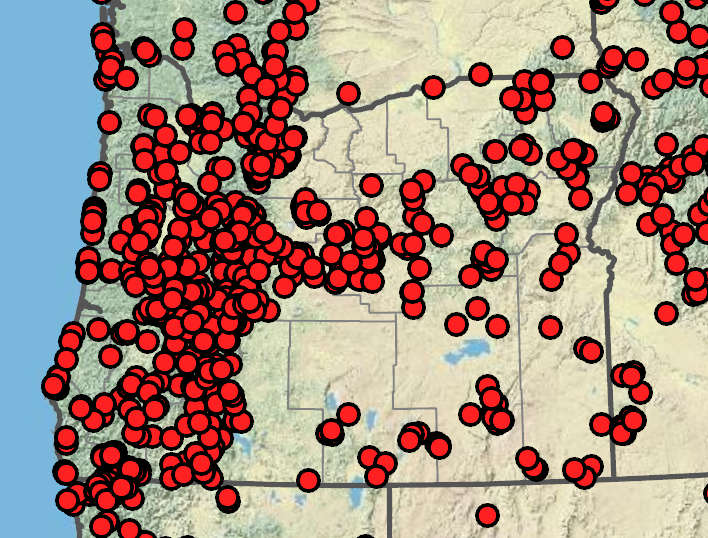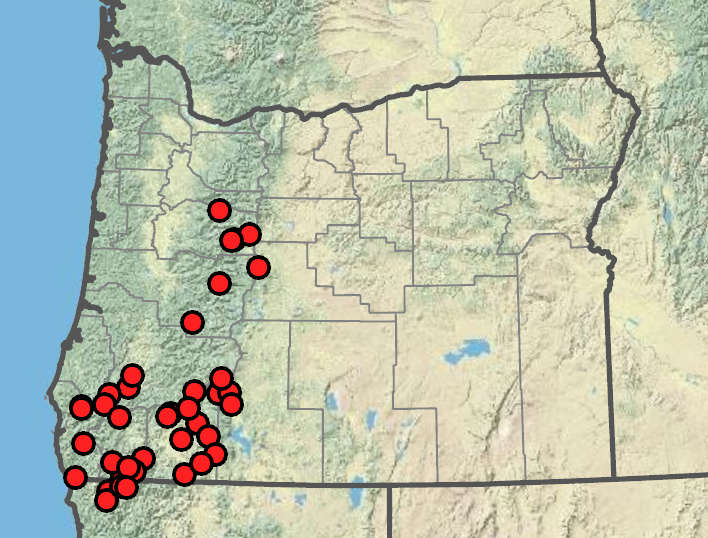Juncus ensifolius
Juncus exiguus
dagger-leaved rush, swordleaf rush
Klamath rush, weak rush
flat; iris-like, blue-green, partially septate;
auricles usually absent (0.1–0.4 mm).
lacking blades;
proximal sheaths smooth (at 10×);
distal sheaths 3–14 cm;
distal half green to pale brown; thin; dull, not papillose; nerves prominent;
apices symmetrical, unwinged; thin; dark and often slightly inrolled towards stem.
1–12(22) clusters; clusters often head-like, 3–70-flowered.
loose clusters;
branches visible;
inflorescence bracts not swollen; erect in fruit.
tepals 6, brown to often dark brown or black;
stamens 3;
filaments 0.6–1.1 mm;
anthers 0.4–0.7 mm;
styles 0.2–0.8(1) mm.
tepals 6, usually mid to dark brown-striped;
stamens 3;
filaments 0.3–0.8 mm;
anthers (0.3)0.4–0.8(0.9) mm;
styles 0.2–0.3 mm.
longer than or equaling tepals, dark brown to blackish;
apices obtuse or acute and abruptly tapered to short beak, 1-chambered.
2.2–3 mm; shorter than or equaling the tepals; light to dark brown, 1-chambered.
0.4–0.5(0.6) × 0.15–0.2 mm, apiculate, reticulate.
0.35–0.5 × 0.2–0.25 mm, reticulate, apiculate.
Juncus ensifolius
Juncus exiguus
Shores, swales, springs, wet meadows, wet prairie, damp dunes, peatlands, ditches. 0–2500m. Throughout Oregon. CA, ID, NV, WA; north to Alaska, east to Saskatchewan, SD and CO, south to AZ and Mexico; Ontario and Quebec south to WI and NY; HI; northeastern Asia, Europe, New Zealand. Native.
With three stamens, this species is reliably separated from J. saximontanus, which has six stamens. Rare plants with variable stamen numbers in an inflorescence may represent hybrids and need investigation.
Shores, wet meadows, marshes, stream banks, springs, peatlands. 900–2300m. CR, Sisk, Casc. CA; southeast to AZ. Native.
The fresh upper stems of this species are variable, but are often smooth, green, and shiny. Upon drying they become blue-green and clearly ridged, so the plants look quite different in the field and in a herbarium. Similar Juncus hesperius is found at lower elevations and has papillose proximal sheaths; J. exiguus is montane and is never papillose.
Peter Zika
Peter Zika
- Local floras:
BC,
CA,
OR,
WA
- Local Web sites:
CalFlora,
CalPhotos,
Flora NW,
PNW Herbaria
WildflowerSearch
iNaturalist (observations)
USDA Plants Database
- LBJ Wildflower Center
- SEINet
- Plants of the World Online
- Encyclopedia of Life
- Wikipedia
- Google Image Search
- Local floras:
CA,
OR
- Local Web sites:
CalFlora,
CalPhotos,
Flora NW,
PNW Herbaria
WildflowerSearch
iNaturalist (observations)
- LBJ Wildflower Center
- SEINet
- Plants of the World Online
- Encyclopedia of Life
- Wikipedia
- Google Image Search


